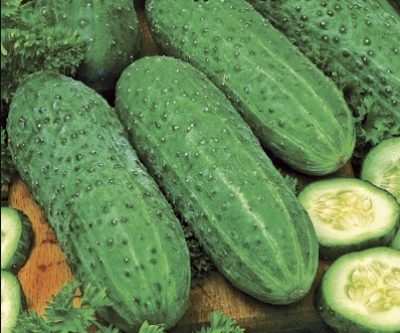
- Authors: Borisov A.V., Krylov O.N., Orekhova E.A., Krylova T.I., Goryachenkov A.V., Vostrikova O.R.
- Year of approval: 2007
- Growth type: indeterminate
- Branching: the average
- Fruit weight, g: 105
- Fruit length, cm: 9-12
- Fruit color: bright green with medium stripes
- Cucumber Mosaic Virus Resistance: stable
- Ripening terms: early
- Fruit shape: cylindrical
Cucumber Hit of the season is so named for a reason. For many gardeners, this variety is indeed the leader in the ranking. Therefore, they continue to plant it on their plots every year. The parthenocarpic hybrid, which appeared in 2007, is distinguished by its unpretentiousness, excellent immunity and pleases with rich harvests. Therefore, its popularity is quite justified. This variety has other advantages.
Description of the variety
The hybrid does not need pollination by bees, it feels equally well in open beds, in temporary film structures and in greenhouses. It is shade-tolerant, resistant to adverse weather conditions, including frost. Moreover, the fruits are always juicy and tasty.
Characteristics of the appearance of plants and zelents
The type of growth of the bushes of this variety is indeterminate. The branching is average. Active regrowth of lateral shoots is observed. Leaves are medium in size, with a traditional green color. The flowering type is female.
Cucumbers grow in bunches of 2-6 pieces. The fruits are compact (no more than 12 cm long). The weight of one vegetable can reach 105 g. Bright green, with small stripes, cucumbers look very attractive. Therefore, the variety is often grown for the purpose of selling.
Purpose and taste of fruits
The dense crispy flesh of these cucumbers goes well with other fresh vegetables in salads. And also the fruits are great for pickling and canning. They are not bitter at all and receive high marks from even the most fastidious gourmets.
Maturation
The hybrid is included in the group of early vegetables. Only 40 days pass from germination to the beginning of fruiting. Considering that seeds for seedlings are sown at the end of April, cucumbers appear already at the beginning of summer.
Yield
A vegetable grower can receive up to 12 kg of ripe fruits from each square meter. In this case, the crop can be harvested until the fall. The cucumbers have rather high shelf-life and resistance to long-distance transportation, so for the owners of commercial enterprises, the culture of this variety can be a real boon.
Growing regions
The hybrid is successfully cultivated in the Central Black Earth Region, in the North Caucasus, in the Volga-Vyatka and Middle Volga regions. And also it can be grown in the northwest and in the center of the country.
Landing scheme
If the option of growing cucumbers in a greenhouse is chosen, it is better to have no more than 2.5 plants per 1 square meter. If the seedlings are placed in an open area, another recommendation applies - 3-4 bushes per m2.
Growing and care
To obtain the maximum possible yield, the seeds of this variety should be processed in a growth stimulator. As for adult plants, standard agricultural technology is relevant here. It is necessary to moisten the soil under the bushes with warm water 3 times a week. If the summer is hot and dry, watering is done more often. If the weather is rainy, on the contrary, the number of procedures is reduced. Fertilizers are applied 2.5 weeks after planting, during the flowering period and every 10-15 days after that. Organic is great for this variety. And also do not forget about the formation of bushes and regular hilling.

In order to collect strong, tasty and beautiful cucumbers on your site, you need to make top dressing. Lack of nutrients can negatively affect the appearance of the plant and significantly reduce the yield. Fertilize cucumbers with organic fertilizers in combination with mineral fertilizers. With the right balance of these components and adherence to the fertilizing schedule, the cucumber yield will be maximum.
Disease and pest resistance
The hybrid is resistant to cucumber mosaic virus, cladosporiosis (brown olive spot), powdery mildew. It is tolerant to root rot and downy mildew. If signs of white rot are detected, chalk and potassium permanganate are used, combining the processing of plants with aerating the greenhouse and stopping watering. Bacteriosis and anthracnose are fought with appropriate chemicals. Wood ash can be used to repel pests.

Despite their popularity, cucumbers are often attacked by diseases and pests. From them, cucumber plantings often die before the start of fruiting. In order to prevent this from happening, it is necessary to try to prevent ailments or get rid of them at the very beginning, having studied in detail their causes of occurrence, signs and methods of treatment.
Review overview
Gardeners growing this hybrid talk about friendly shoots and bountiful harvests. Usually there are no difficulties in caring for the culture. As for the palatability of the fruits, they delight all vegetable lovers. Cucumbers are good both fresh and canned. Therefore, many summer residents purchase seeds of this variety again.





























































































